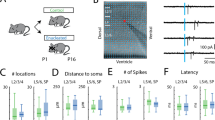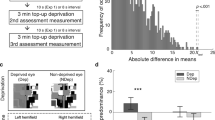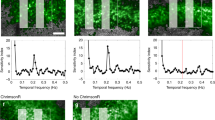Abstract
When a kitten is subjected to monocular lid suture early in life, cells in laminae of the lateral geniculate nucleus (LGN) connected to the sutured eye grow less than normal and cells in those laminae connected to the non-sutured eye grow more than normal1–5. These changes are seen primarily in the binocular segment of the LGN, which corresponds to the central visual field, and are due to competition either between intracortical afferents originating from the different LGN laminae, or directly among cells within the LGN2,6. The afferent deprivation induced by lid suture, however, is not complete, as retinal ganglion cells fire tonically both in darkness and in light7. It is generally thought that this tonic retinal activity is necessary to maintain neuronal excitability at normal threshold in the central visual pathway8–10. In the visual cortex of developing kittens, we previously showed a long-lasting change in ocular dominance of binocular cells by a brief blockade of retinal activity in one optic nerve11. We report here that a complete blockade of retinal activity in one eye causes major changes in LGN cell size within 1 week. These changes occur throughout the LGN, including the monocular segment where binocular competition does not occur. The results indicate that tonic retinal activity may have an important role in the control of geniculate cell size.
This is a preview of subscription content, access via your institution
Access options
Subscribe to this journal
Receive 51 print issues and online access
$199.00 per year
only $3.90 per issue
Buy this article
- Purchase on Springer Link
- Instant access to full article PDF
Prices may be subject to local taxes which are calculated during checkout
Similar content being viewed by others
References
Wiesel, T. N. & Hubel, D. H. J. Neurophysiol. 26, 978–993 (1963).
Guillery, R. W. & Stelzner, D. J. J. comp. Neurol. 139, 413–422 (1970).
Hickey, T. L., Spear, P. D. & Kratz, K. E. J. comp. Neurol. 172, 265–282 (1977).
Hoffmann, K.-P. & Holländer, H. J. J. comp. Neurol. 177, 145–158 (1978).
Kalil, R. J. comp. Neurol. 189, 483–524 (1980).
Guillery, R. W. J. comp. Neurol. 144, 117–130 (1972).
Kuffler, S. W., FitzHugh, R. & Barlow, H. B. J. gen. Physiol. 40, 683–702 (1957).
Granit, R. Receptors and Sensory Perception. (Yale University Press, New Haven, 1955).
Chang, H. T. J. Neurophysiol. 15, 5–26 (1952).
Arduini, A. & Hirao, T. Archs Ital. Biol. 98, 182–205 (1960).
Kasamatsu, T. Expl Brain Res. 26, 487–494 (1976).
Kuppermann, B. & Kasamatsu, T. Soc. Neurosci. Abstr. 6, 790 (1980).
Stryker, M. P., Soc. Neurosci. Abstr. 7, 842 (1981).
Archer, S. M., Dublin, M. W. & Stark, L. A. Science 217, 743–745 (1982).
Humason, G. L. Animal Tissue Techniques, 79–81 (Freeman, San Francisco, 1972).
Sanderson, K. J. J. comp. Neurol. 143, 101–118 (1971).
Author information
Authors and Affiliations
Rights and permissions
About this article
Cite this article
Kuppermann, B., Kasamatsu, T. Changes in geniculate cell size following brief monocular blockade of retinal activity in kittens. Nature 306, 465–468 (1983). https://doi.org/10.1038/306465a0
Received:
Accepted:
Issue Date:
DOI: https://doi.org/10.1038/306465a0
This article is cited by
-
Cytomorphometric changes in the dorsal raphe neurons after rapid eye movement sleep deprivation are mediated by noradrenalin in rats
Behavioral and Brain Functions (2010)
-
Differential induction of c-Fos and c-Jun in the lateral geniculate nucleus of rats following unilateral optic nerve injury with contralateral retinal blockade
Experimental Brain Research (2009)
-
Ocular dominance shift in kitten visual cortex caused by imbalance in retinal electrical activity
Nature (1986)
-
Elimination of action potentials blocks the structural development of retinogeniculate synapses
Nature (1986)
Comments
By submitting a comment you agree to abide by our Terms and Community Guidelines. If you find something abusive or that does not comply with our terms or guidelines please flag it as inappropriate.



